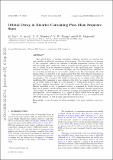Orbital decay in binaries containing post-main-sequence stars
Author(s)
Sun, M; Arras, P; Weinberg, NN; Troup, NW; Majewski, SR
DownloadAccepted version (2.529Mb)
Terms of use
Metadata
Show full item recordAbstract
© 2018 The Author(s). Published by Oxford University Press on behalf of the Royal Astronomical Society. The orbital decay of binaries containing a primary subgiant or red giant star and a stellar or substellar companion is investigated. The tide raised in the primary by the companion leads to an exchange of angular momentum between the orbit and the stellar spin, causing the orbit to contract and the primary to spin-up. The rate of orbital decay is computed including both the equilibrium tide, damped by turbulent viscosity in the convective envelope, and the dynamical tide, assumed to be a traveling internal-gravity wave in the radiative core. For close binaries, the tidal forcing period is expected to be much shorter than the eddy turnover timescale in the convective envelope, and the prescription for 'reduced' viscosity is an important consideration. The dynamical tide tends to dominate for the closest orbits,while the equilibrium tide dominates for more distant orbits, with the crossover point depending on the stellar mass. The spin-up of the primary to synchronous rotation occurs for sufficiently massive secondaries, and this greatly slows the orbital decay until the Darwin instability occurs. A parameter survey is presented for orbital decay as a function of primary and secondary mass, as well as turbulent viscosity prescription. These results are summarized with analytic formulae and numerical results for the age-dependent critical separation, acrit, inside of which orbital decay is rapid, and few systems are expected to be observed. The calculations of acrit are compared with APOGEE binaries, as well as solar mass exoplanet host stars.
Date issued
2018Department
Massachusetts Institute of Technology. Department of Physics; MIT Kavli Institute for Astrophysics and Space ResearchJournal
Monthly Notices of the Royal Astronomical Society
Publisher
Oxford University Press (OUP)